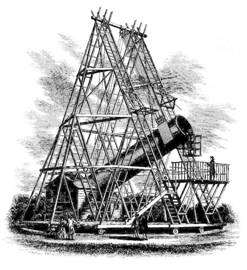- 1610: Galileo
- 1676: Ole Rømer
- 1687: Isaac Newton
- 1781: William Herschel
- 1838: Friedrich Bessel
- 1861: William and Margaret Huggins
- 1912: Henrietta Leavitt
- 1917 Einstein
- 1920: Harlow Shapley
- 1929 Edwin Hubble
- 1948: Ralph Alpher
- 1949: Fred Hoyle
- 1963: Maarten Schmidt
- 1964: Arno Penzias and Robert Wilson
- 1978: Vera Rubin and Kent Ford
- 1989: Margaret Geller and John Huchra
- 1992: John Mather and George Smoot
- 1995: Robert Williams
- 1998: Saul Perlmutter and Brian Schmidt
- 2010: Wendy Freedman
The First Truly Large Telescopes
 Like Newton’s telescope, Herschel’s telescopes used concave mirrors rather than lenses. Concave mirrors are not easy to make, since they must be ground and polished to within a few millionths of an inch. Nonetheless, they are much easier to fabricate than lenses which require at least two glass surfaces. Also the glass of a telescope lens must be perfectly clear with no bubbles since light from a star must pass all the way through the glass without distortion.
Like Newton’s telescope, Herschel’s telescopes used concave mirrors rather than lenses. Concave mirrors are not easy to make, since they must be ground and polished to within a few millionths of an inch. Nonetheless, they are much easier to fabricate than lenses which require at least two glass surfaces. Also the glass of a telescope lens must be perfectly clear with no bubbles since light from a star must pass all the way through the glass without distortion.
The example at left: Herschel’s largest telescope was nearly 4 feet in diameter and 40 feet long. Notice the man on the observing platform for scale.